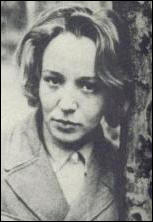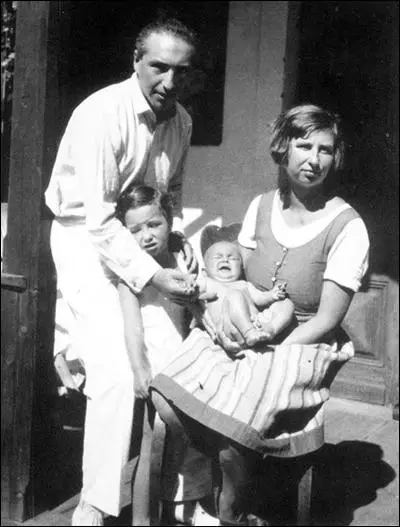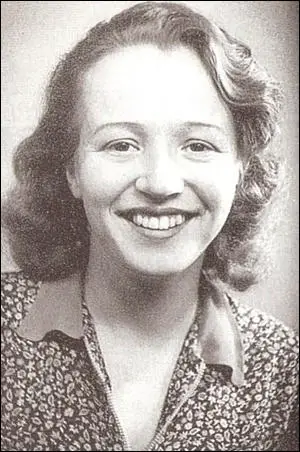Elsa Lindenberg

Elsa Lindenberg was born in Germany in 1906. When she was nine years old she won a scholarship to attend the Helene Lange School in Berlin. She completed her education at the Laban School, run by Herta Feist, a leading figure in the German nudist movement, who became famous for her choreography of naked performances and her belief in the therapeutic powers of nude dance. (1)
In 1927 Lindenberg danced at the Municipal Opera House in Berlin where one of the founders of modern dance, Rudolf von Laban, was director of ballet. Karl Toepfer, the author of Empire of Ecstasy: Nudity and Movement in German Body Culture (1997), has argued that Laban "equated the liberated body not with an enhanced power to signify a wide range of emotions but with the power to signify and/or experience a single, great, supreme emotion: ecstasy." (2)
Elsa Lindenberg met Wilhelm Reich, the psychologist, in May, 1932, during a protest demonstration against Adolf Hitler and the Nazi Party. She later recalled that "I got to know Willie Reich when I used to walk around Berlin at night with a pot of glue and anti-Hitler posters." (3)
Reich was married to Annie Reich but was well-known for his womanizing. In his essay, Compulsory Marriage and Enduring Sexual Relationship (1930) Reich argued that sooner or later sexual attraction between a couple dried up and they were invariably drawn to others. "The healthier the individual the more conscious he is of his desires." It is clearly an autobiographical article and he indicated that he disliked Annie's toleration of his sexual relationships with other women: "The unconscious hatred (toward the partner to which you are no longer as sexually attracted as you once were) can become all the more intense the kinder and more tolerant the partner is." (4)

Anna Freud recommended that Annie Reich left her husband. She did this but eventually returned to the family home. Later, his daughter, Lore Reich, explained what happened: "He had lots of affairs, and he felt that if didn't go along with that you were just clingy and neurotic. This was totally different if women cheated on him... But anyway, he was having these yelling matches and things, and he was being crazy in many ways and she was in analysis, so she was telling all this to Anna Freud, and I am sure she told Freud... My mother was a very modern woman. She became a psychoanalyst. She was highly intellectual, very cultured, and she became very successful in her field. Her problem was that she should have left him when he went to Berlin, but she didn't, she went back to him." (5)
Annie later wrote about her sexual relationship with her husband: "Intercourse is an experience of extraordinary intensity in these cases of extreme submissiveness in women. It is worthy of note that the self-esteem of the submissive woman falls to a strikingly low level when she is away from her lover. The man, on the other hand, is overrated; he is considered to be very important, a genius. He is the only man worthy of love... she develops a sort of megalomania in regard to him. In the magic of unio mystica she finally regains, through identification, the narcissism which she had renounced." (6)
Adolf Hitler became Chancellor in January 1933. The Nazi Party still didn't have a clear parliamentary majority, however, on 27th February, 1933, someone set fire to the Reichstag. Several people were arrested including a leading, Georgi Dimitrov, general secretary of the Comintern, the international communist organization. Dimitrov was eventually acquitted but a young man from the Netherlands, Marianus van der Lubbe, was executed for the crime. As a teenager Lubbe had been a communist and Hermann Goering used this information to claim that the Reichstag Fire was part of a German Communist Party (KPD) plot to overthrow the government. Hitler gave orders that all leaders of the KPD should "be hanged that very night." (7)
As a Jew and a communist, orders were given for Reich's arrest. However, the family went into hiding. In March, 1933, Völkischer Beobachter published an attack on Reich's pamphlet, The Sexual Battle of Youth. Annie and Wilhelm now escaped to Vienna to meet up with their two daughters, who had already been sent to live with their grandparents. (8)
On April 21, 1933 Elsa Lindenberg and her friend, Ruth Abramowitsch, were formally excluded from the ballet group under the Law for the Restoration of the Professional Civil Service . She was accused of "state damaging behavior". Lindenberg decided to join Wilhelm Reich in Vienna. It was at this point that Annie Reich decided to leave her husband. Lore later recalled that her mother lost "all the admiration and submissiveness, and the belief that he was a great man." (9) Annie wrote to Elsa that "your happiness will be built on my tears". (10)
After the publication of The Mass Psychology of Fascism, Reich and Lindenberg moved on to Denmark. The book made him unpopular with the Danish Communist Party as they regarded it as "counterrevolutionary". He was also criticised for his promotion of abortion and sex education. When his visa expired, it was not renewed. He therefore decided to apply to live in England. (11)
However, leading figures in psychoanalysts, Melanie Klein, Anna Freud, Ernest Jones, Joan Riviere and James Strachey all refused to support his application because of his hostility to the theories of Sigmund Freud. Anna attempted to explain her opposition to Reich: "There is a wall somewhere where he (Wilhelm Reich) stops to understand the other person's point of view and flies off into a world of his own... He is an unhappy person... and I am afraid this will end in sickness." (12)
Reich and Lindenberg moved instead to Malmö in Sweden, but he government declined to extend his visa, and the couple had to move briefly back to Denmark. They finally settled in Oslo, Norway, in October, 1934. Reich described Lindenberg as his "companion-wife". He began conducting investigations into sexual electricity. This was an idea first proposed by Sigmund Freud who suggested that the libido was made up of some "chemical substance". According to Ernest Jones, Freud had dreamed of "transforming psychology into a biological or physiological discipline." (13)
Reich purchased an oscillograph, a device designed to measure and record electrical charge, and began to try to quantify the libido, rigging up the nipples and genitalia of various volunteers with silver electrodes. He wrote to his friend, Ellen Siersted: "It is the beginning... and within three years we will be able to state that Freud, long ago, had found how to measure the electrical power of sexuality!" (14)
Reich, who had no previous experience of laboratory work, wrote to his estranged wife that in this regard he felt like an "untrained tourist... standing at the foot of Mount Everest." (15) Reich eventually concluded that the oscillograph was a sort of lie detector test for orgastic potency. "He claimed that his machine could distinguish between an orgasm and a total orgasm, only the latter being properly accompanied by liberated energies, as recorded by the oscillograph, no matter what the subject said he or she felt." (16)
Several of his friends served as test subjects for these bioelectric experiments. This included Willy Brandt, a German socialist who had fled to Norway, where he established the International Bureau of Revolutionary Youth Organizations. Lindenberg compared the two men: "Brandt was very calm, with a clear, sharp mind. There was an inner restlessness there due to his political involvement but he kept it under control... Wilhelm Reich was also feeling this inner restlessness but he made no attempt to control it." (17)
Over the next few months Reich also conducted what he called the bion experiments. This involved growing cultured vesicles using grass, sand, iron and animal tissue, boiling them and adding potassium and gelatin. Having heated the materials to incandescence with a heat-torch, he wrote that he had discovered "bions" and believed they were a rudimentary form of life, halfway between life and non-life. He wrote that when he poured the cooled mixture onto growth media, bacteria were born, dismissing the idea that the bacteria were already present in the air or on other materials. (18)
Wilhelm Reich published The Sexual Revolution in 1936. He argued in the book: "The healthy individual has no compulsive morality because he has no impulses which call for moral inhibition... Intercourse with a prostitute becomes impossible. Sadistic phantasies disappear. To expect love as a right or even to rape the sexual partner becomes inconceivable, as do ideas of seducing children. Anal, exhibitionistic or other perversions disappear, and with these the social anxiety and guilt feelings. The incestuous fixation to parents and siblings loses its interest; this liberates the energy which was bound up in such fixations. In brief, all these phenomena point to the fact that the organism is capable of self-regulation." (19)
Reich also suggested that a long-term successful marriage was difficult to achieve: "Marriages could be good, at least for a certain period of time, if there were sexual harmony and gratification. This would, however, presuppose a sex affirmative education, premarital sexual experience, and emancipation from conventional morality. But the very thing that might make for a good marriage means at the same time its doom. For once sexuality is affirmed, once moralism is overcome, there is no longer any inner argument against intercourse with other partners except for a period of time, during which faithfulness based on gratification exists (but not for a life-time). The ideology of marriage collapses and with it the marriage. It is no longer marriage, but a permanent sexual relationship." (20)
Some feminists have attacked the views of Wilhelm Reich and Herbert Marcuse for being sexist. Beatrice Faust has argued: "Both Marcuse and Reich saw sexual repression as a weapon of authoritarian, patriarchal culture and economic exploitation although the former was directly concerned with European fascism while the latter was concerned to expose the fascism that he believed was latent in the affluent democracies. Both related the Freudian concepts of repression and sublimation in the psychic economy to destructive forces in capitalism, anticipating revolutionary changes in both individuals and in society." Like two other radical thinkers, Karl Marx and Sigmund Freud... Reich and Marcuse... "both disguised inherent conservatism by a facade of self-righteous non-conformism." (21)

Reich had originally believed that Lindenberg ideas on modern dance was intimately linked to sexual freedom. However, as the relationship deteriorated, he began to ridiculed Lindenberg's dancing. He also began to suspect her of having an affair with her pianist. He turned up at the man's house unannounced and caused a scene that included breaking a mirror and throwing around some chairs. Although he believed in free love for himself, he was extremely jealous of his partners having relationships with other men. That night Lindenberg left Reich. (22)
Reich now decided he would like to join his former wife and their two daughters in the United States. Theodore P. Wolfe, a professor of psychiatry at Columbia University, who had translated The Mass Psychology of Fascism into English, offered to help him and made contact with Adolph Berle, an official in the State Department. He received the visa and sailed out of Norway on 19th August, 1939, on the SS Stavangerfjord, the last ship to leave for the United States before the war began on 3rd September. (23)
Lindenberg remained in Oslo. As a result of investigations by the Secret State Police, she was forced to enter into a marriage of convenience with a Norwegian. In 1944 she secretly returned to Nazi Germany before moving on to Sweden. At the end of the Second World War she returned to Norway, but was persecuted as a German. Later she was rehabilitated by the Norwegian government and received a state pension.
Elsa Lindenberg died on 6th November, 1990.
Primary Sources
(1) Wilhelm Reich, Compulsory Marriage and Enduring Sexual Relationship (1930)
The healthier the individual the more conscious he is of his desires." It is clearly an autobiographical article and he indicated that he disliked Annie's toleration of his sexual relationships with other women: "The unconscious hatred (toward the partner to which you are no longer as sexually attracted as you once were) can become all the more intense the kinder and more tolerant the partner is.
(2) Wilhelm Reich, The Sexual Revolution (1936)
Marriages could be good, at least for a certain period of time, if there were sexual harmony and gratification. This would, however, presuppose a sex affirmative education, premarital sexual experience, and emancipation from conventional morality. But the very thing that might make for a good marriage means at the same time its doom. For once sexuality is affirmed, once moralism is overcome, there is no longer any inner argument against intercourse with other partners except for a period of time, during which faithfulness based on gratification exists (but not for a life-time). The ideology of marriage collapses and with it the marriage. It is no longer marriage, but a permanent sexual relationship. Such a relationship, because of the absence of suppression of genital desires, is more apt to prove happy than strictly monogamous marriage. In many cases, the cure for an unhappy marriage-moralists and authoritarian law notwithstanding – is marital infidelity.
(3) Annie Reich, Extreme Submissiveness in Women (1939)
Intercourse is an experience of extraordinary intensity in these cases of extreme submissiveness in women. It is worthy of note that the self-esteem of the submissive woman falls to a strikingly low level when she is away from her lover. The man, on the other hand, is overrated; he is considered to be very important, a genius. He is the only man worthy of love... she develops a sort of megalomania in regard to him. In the magic of unio mystica she finally regains, through identification, the narcissism which she had renounced.
Student Activities
Economic Prosperity in the United States: 1919-1929 (Answer Commentary)
Women in the United States in the 1920s (Answer Commentary)
Volstead Act and Prohibition (Answer Commentary)
The Ku Klux Klan (Answer Commentary)
Classroom Activities by Subject
